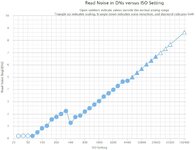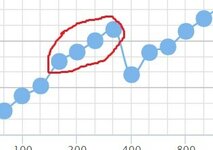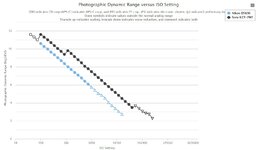Hello,
Yesterday while answering a thread I was sidetracked looking at some information that I think would benefit our members. Let's begin.
Most of us have a pretty good understanding of what ISO is, but for those who unaware ISO is gain, when we increase it we raise the sensor's sensitity to light and therefore we get a brighter image but there is a penalty for this, when we raise gain it is not just signal (the actual image - good stuff) increasing we are also raising noise (grain - the badstuff) which ends up creating grainy/noisy images if there is too much noise to signal ratios. For this same reasons most photographers learn early to try to keep their ISO low whenever possible but newer technology is changing this to a degree.
Dual ISO circuit:
In the past ISO technology was more straight forward, if you were to measure the noise to signal ratio at different ISOs for an older camera like this almost 20 year old Canon 20D I have used for this example, it would look something like this:

As you can see with this graph above in mind the concept of keeping ISO low seems logical and makes sense across all ISO ranges. But newer cameras now more commonly use dual ISO circuits and this means that their graph looks more often like this (Nikon Z 7ii used for this example):

Obvious differences like the ISO range will of course be better with the newer camera, hardly a surprise, but what we need to notice is the shape of the graph, particularly here:

These 4 ISO ranges are ISO 160, 200, 250 and 320 and they all have worst noise to signal ratio than ISO 400, this is because for Nikon Z 7ii, ISO 400 is where the second circuit is active and this drives down the noise level at this ISO. In this type of ISO profile the concept of lower ISO is always better is not always true. For this camera, Iower ISOs up to 125 are better but ISO 160-320 are best avoided to be replaced by ISO 400 whenever possible. After ISO 400 the concept of lower ISO is better rings true once again. For those that want this last part recapped - Yes, your camera will take a less noisier shot at a higher ISO where it's second ISO circuit is active than a photo at a lower ISO without a dual ISO circuit. Avoid the first peak in the graph that are above the dual circuit's level like the ones highlighted in red in the graph above.
ISO invariance adds another layer to this but we can discuss this further later. What I would highly recommend for anyone that owns a camera or mobile to head to Photons to photo's website and pick their camera model on the right side panel and you will then be able to see and get to know a little more about your camera's ISO profile, whether you have dual ISO or not and if you do have it - what is your dual ISO number? On My Sony a7iii ISO 640 is my dual ISO and I avoid ISO 250-500 when possible. I would love to hear your opinions, experiences, questions. How many of you were already aware of this and use this concept? Hope it helps
Yesterday while answering a thread I was sidetracked looking at some information that I think would benefit our members. Let's begin.
Most of us have a pretty good understanding of what ISO is, but for those who unaware ISO is gain, when we increase it we raise the sensor's sensitity to light and therefore we get a brighter image but there is a penalty for this, when we raise gain it is not just signal (the actual image - good stuff) increasing we are also raising noise (grain - the badstuff) which ends up creating grainy/noisy images if there is too much noise to signal ratios. For this same reasons most photographers learn early to try to keep their ISO low whenever possible but newer technology is changing this to a degree.
Dual ISO circuit:
In the past ISO technology was more straight forward, if you were to measure the noise to signal ratio at different ISOs for an older camera like this almost 20 year old Canon 20D I have used for this example, it would look something like this:

As you can see with this graph above in mind the concept of keeping ISO low seems logical and makes sense across all ISO ranges. But newer cameras now more commonly use dual ISO circuits and this means that their graph looks more often like this (Nikon Z 7ii used for this example):

Obvious differences like the ISO range will of course be better with the newer camera, hardly a surprise, but what we need to notice is the shape of the graph, particularly here:

These 4 ISO ranges are ISO 160, 200, 250 and 320 and they all have worst noise to signal ratio than ISO 400, this is because for Nikon Z 7ii, ISO 400 is where the second circuit is active and this drives down the noise level at this ISO. In this type of ISO profile the concept of lower ISO is always better is not always true. For this camera, Iower ISOs up to 125 are better but ISO 160-320 are best avoided to be replaced by ISO 400 whenever possible. After ISO 400 the concept of lower ISO is better rings true once again. For those that want this last part recapped - Yes, your camera will take a less noisier shot at a higher ISO where it's second ISO circuit is active than a photo at a lower ISO without a dual ISO circuit. Avoid the first peak in the graph that are above the dual circuit's level like the ones highlighted in red in the graph above.
ISO invariance adds another layer to this but we can discuss this further later. What I would highly recommend for anyone that owns a camera or mobile to head to Photons to photo's website and pick their camera model on the right side panel and you will then be able to see and get to know a little more about your camera's ISO profile, whether you have dual ISO or not and if you do have it - what is your dual ISO number? On My Sony a7iii ISO 640 is my dual ISO and I avoid ISO 250-500 when possible. I would love to hear your opinions, experiences, questions. How many of you were already aware of this and use this concept? Hope it helps
Last edited:


